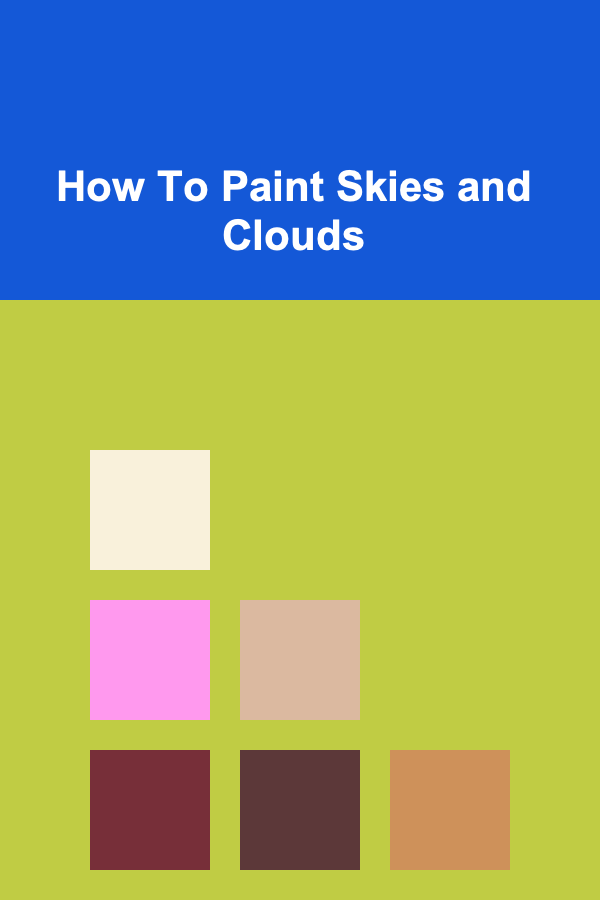
How To Paint Skies and Clouds
ebook include PDF & Audio bundle (Micro Guide)
$12.99$6.99
Limited Time Offer! Order within the next:

Painting skies and clouds is a captivating and essential skill for any landscape artist. The sky often serves as the backdrop for a painting, setting the mood, tone, and atmosphere of the entire scene. Whether you're aiming to create a soft and dreamy sky, a dramatic storm, or a tranquil evening sunset, mastering the techniques for painting skies and clouds can bring your work to life.
In this guide, we will explore various aspects of sky and cloud painting, including understanding the nature of the sky, the tools and materials you'll need, techniques for creating different types of skies, and tips for adding realistic clouds to your artwork.
Understanding the Sky
Before diving into the process of painting skies and clouds, it's crucial to have a foundational understanding of the sky's nature. The sky is not a static backdrop; it constantly changes depending on the time of day, weather conditions, and geographical location. Different types of skies evoke different emotions and atmospheres. Here are some important aspects to keep in mind:
1. The Color of the Sky
The color of the sky varies significantly throughout the day and under different weather conditions. During the day, the sky is typically blue due to the scattering of sunlight by the atmosphere. However, as the sun rises or sets, the sky may take on shades of pink, orange, purple, and red, creating a dynamic range of colors. Overcast skies may be muted gray, while a stormy sky can have ominous dark clouds.
When painting the sky, it's important to consider the light source. For instance:
- Daytime skies are often a gradient from light to dark, with the lightest part near the horizon.
- Dawn and dusk skies feature warmer hues, with more intense contrasts between the warm colors near the horizon and the cooler tones in the upper parts of the sky.
- Stormy skies are darker and more chaotic, often featuring dramatic lighting and dark, dense clouds.
2. The Atmosphere
The atmosphere plays a key role in the appearance of the sky. Factors such as humidity, air pollution, and time of year affect how light interacts with the atmosphere, which in turn influences the colors and visibility of clouds.
Clouds, for example, are formed when water vapor condenses in the atmosphere. The variety of clouds --- from fluffy cumulus clouds to wispy cirrus clouds --- depends on the moisture levels, air currents, and temperature conditions.
3. Light and Shadow
The positioning of the sun in the sky determines the amount of light and shadow in your painting. When painting the sky, it's crucial to understand how light affects the color and texture of the clouds. The sun's rays can create strong contrasts between light and dark areas, with shadows in the clouds being more intense when the sun is lower on the horizon, like during sunrise or sunset.
Tools and Materials for Painting Skies and Clouds
To create a beautiful sky and realistic clouds, you'll need the right tools and materials. The medium you choose will also affect how you approach the painting process. Whether you're using watercolors, oils, or acrylics, each medium offers different advantages.
1. Watercolors
Watercolors are an excellent medium for painting skies, especially when you want to capture the soft transitions of light in the sky. The transparent nature of watercolors allows for delicate blending and smooth gradients, which is ideal for creating realistic skies.
Recommended Tools for Watercolor Sky Painting:
- Watercolor paints: Choose a range of blues, purples, oranges, and reds for varying sky conditions.
- Watercolor brushes: A flat, wide brush works well for washes, while a smaller round brush is useful for cloud details.
- Watercolor paper: Use high-quality watercolor paper that can absorb water without warping.
2. Oils
Oil paints are well-suited for creating rich, textured skies with more intense color contrasts. They are slow-drying, which gives you time to blend colors and create smooth transitions.
Recommended Tools for Oil Sky Painting:
- Oil paints: Choose a range of blues, whites, and other colors that fit your scene. Use glazes for a more luminous effect.
- Brushes: Use a variety of brushes, from large flat brushes for sky washes to smaller, detail brushes for cloud texture.
- Palette knives: Palette knives can be used to create texture in clouds and rough skies.
3. Acrylics
Acrylic paints are versatile and fast-drying, making them a great option for quick studies or detailed skies. They can be used to create both smooth skies and textured clouds, depending on how you apply them.
Recommended Tools for Acrylic Sky Painting:
- Acrylic paints: Acrylics dry quickly, so work fast for gradient effects, or use slow-drying mediums to extend the time for blending.
- Brushes: Use a variety of brushes, including large ones for broad washes and small ones for detailed cloud work.
- Sponges: For a more textured cloud effect, sponges can be used to stipple paint onto the canvas.
Techniques for Painting Skies
Now that you understand the materials and the fundamentals of the sky, let's explore some key techniques for painting skies.
1. Creating Gradients
A gradient is a gradual transition between two or more colors, and it is essential in sky painting to represent the changing hues from horizon to zenith. In watercolors, you can achieve a smooth gradient by wetting the paper first and then applying the paint in layers, working from light to dark. For oil or acrylic paints, use a dry brush technique to blend the colors while they are still wet.
2. Layering Colors for Depth
Layering colors helps to create depth and dimension in the sky. Start with a base color that reflects the mood of the scene. For example, for a midday sky, you may use light blues, while for a sunset, you might use warm pinks, purples, and oranges.
Add darker colors to the top of the canvas to create the illusion of the sky receding into the distance. The sky should have a lighter, more saturated color near the horizon and gradually fade to a cooler, darker color as you move upward.
3. Wet-on-Wet Technique
This technique is especially effective when using watercolors and oils. Wet-on-wet allows you to blend colors directly on the canvas or paper while the surface is still wet. This results in soft, blended transitions in the sky, perfect for creating the smooth, atmospheric effects often seen at dawn or dusk.
4. Glazing
In oil painting, glazing is a technique where you apply a thin, transparent layer of paint over a dried layer of paint. Glazing can give the sky depth and luminosity, especially when painting evening skies or clouds lit by the sun. Glazing also allows you to adjust the tone and color of the sky without disturbing the layers beneath.
5. Dry Brush Technique
The dry brush technique is useful for adding texture to clouds. Using a dry brush (one that is relatively free of paint and moisture), you can lightly drag the brush across the canvas to create soft, wispy clouds or textured, turbulent skies. This technique works best with oil or acrylic paints and can be used to create soft edges in the clouds or more defined, rougher textures in stormy skies.
How to Paint Different Types of Clouds
Clouds come in a variety of shapes and textures, each contributing to the atmosphere of your painting. Here are a few common types of clouds and how to paint them:
1. Cumulus Clouds
Cumulus clouds are the classic fluffy, white clouds that we often see on clear days. They are typically found at low altitudes and have a soft, rounded shape.
How to Paint Cumulus Clouds:
- Use a light, fluffy brush or sponge to create the soft, rounded forms.
- Start by painting the base of the cloud with a pale gray or white color and add more detail to the upper part, using highlights of white or pale blue.
- Use a dry brush technique to add texture to the cloud's edges.
2. Cirrus Clouds
Cirrus clouds are high-altitude clouds that are thin and wispy. They often appear as delicate streaks or feather-like formations across the sky.
How to Paint Cirrus Clouds:
- Use a soft, dry brush to create thin, sweeping lines of white or very light gray.
- Make sure to keep the lines soft and uneven to replicate the delicate nature of these clouds.
- Use blending techniques to make sure the clouds appear to be floating delicately in the sky.
3. Stratus Clouds
Stratus clouds are low, gray clouds that often cover the sky in a uniform layer. These clouds can give the sky a gloomy or overcast appearance.
How to Paint Stratus Clouds:
- Use broad, smooth strokes with a soft brush or a sponge to create a uniform, smooth layer of clouds across the sky.
- Gradually layer different shades of gray and blue to create depth.
- For a more realistic effect, you can add a touch of white to some areas to simulate light breaking through the clouds.
4. Thunderstorm Clouds (Cumulonimbus)
Cumulonimbus clouds are massive, towering clouds associated with thunderstorms. These clouds can be dramatic and intense, often filling the sky with deep shades of gray and dark purple.
How to Paint Cumulonimbus Clouds:
- Start with a dark base color, such as a mixture of deep grays, purples, and blues.
- Use a combination of dry brush and glazing techniques to build up the dense, tumultuous structure of the cloud.
- Add highlights of lighter grays or whites around the edges to create contrast and depth.
Final Thoughts
Painting skies and clouds is a rewarding skill that can enhance any landscape painting. By understanding the nature of the sky, using the right materials, and mastering the techniques for creating different types of skies and clouds, you can produce stunning, atmospheric artworks that evoke emotion and capture the essence of the natural world.
Whether you're working with watercolors, oils, or acrylics, remember to take your time with blending, layering, and experimenting with different textures and colors. Each sky and cloud formation is unique, so practice and observation are key to developing your skills.
With patience and dedication, you'll soon be able to paint skies and clouds that are not only realistic but also full of emotion and beauty. Happy painting!

Beginner's Guide to Writing Effective Emails
Read More
How to Keep Your Entryway Clutter-Free and Functional
Read More
How to Plan for Future Hobby Projects with Organization
Read More
The IT Security Specialist's Playbook: Essential Tactics for Safeguarding Networks
Read More
How To Explore Blockchain for Arts and Culture (NFTs)
Read More
How to Set Financial Goals for Specific Life Events (Marriage, Kids, Retirement)
Read MoreOther Products

Beginner's Guide to Writing Effective Emails
Read More
How to Keep Your Entryway Clutter-Free and Functional
Read More
How to Plan for Future Hobby Projects with Organization
Read More
The IT Security Specialist's Playbook: Essential Tactics for Safeguarding Networks
Read More
How To Explore Blockchain for Arts and Culture (NFTs)
Read More